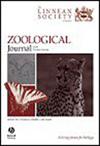Phylogeny and species delimitation in an iconic snake genus: the African mambas (Serpentes: Elapidae: Dendroaspis)
IF 2.8
2区 生物学
Q1 ZOOLOGY
引用次数: 0
Abstract
The African mambas (Dendroaspis) comprise an iconic genus of four large-bodied, highly venomous elapid snakes: the black mamba (D. polylepis) from open formations across sub-Saharan Africa is comprised of two allopatric populations, and three species of green mamba (D. angusticeps, D. jamesoni, and D. viridis) from tropical and sub-tropical forests. Dendroaspis angusticeps occurs in multiple isolated forest patches, and the presence of cryptic species within D. angusticeps has been suggested. The striking coloration of the three green species, a trait unique among elapids, suggests their monophyly to the exclusion of D. polylepis. We generated a dated, multilocus phylogeny of the mambas and assessed species boundaries. Species distribution modelling (SDM) was used to assess the past and present potential connectivity between allopatric populations of D. angusticeps and D. polylepis. The phylogeny suggests that diversification of the crown clade began c. 6 Mya and, contrary to previous suggestions, we found no convincing signal of species-level diversification within D. polylepis or D. angusticeps. The hypothesis of green mamba monophyly was rejected, with D. angusticeps being sister to D. polylepis. The SDMs suggested that allopatric populations of D. polylepis and D. angusticeps were historically connected, and that their vicariance is recent.一个标志性蛇属的系统发育和物种划分:非洲曼巴(蛇纲:蛇科:树齿蛇)
非洲曼巴(Dendroaspis)由一个标志性的四种大型、剧毒的蛇属组成:来自撒哈拉以南非洲开阔地带的黑曼巴(D. polylepis)由两个异域种群组成,来自热带和亚热带森林的三种绿曼巴(D. angusticeps, D. jamesoni和D. viridis)。栓皮栎分布在多个孤立的森林斑块中,并且在栓皮栎中存在隐种。这三种绿色物种的醒目颜色,是elapids中独特的特征,表明它们是单系的,而不包括D. polylepis。我们生成了一个古老的、多位点的曼巴系统发育,并评估了物种边界。采用物种分布模型(SDM)对异域居群间的潜在连通性进行了评估。系统发育表明,冠枝的多样化始于约6亿年前,与之前的观点相反,我们没有发现在d.p olylepis或d.p angusticeps中有令人信服的物种水平多样化的信号。绿曼巴单系假说被否定了,angusticeps绿曼巴是polylepis绿曼巴的姐妹。SDMs结果表明,在历史上,异域居群的分布是有联系的,它们的迁移是最近发生的。
本文章由计算机程序翻译,如有差异,请以英文原文为准。
求助全文
约1分钟内获得全文
求助全文
来源期刊
CiteScore
6.50
自引率
10.70%
发文量
116
审稿时长
6-12 weeks
期刊介绍:
The Zoological Journal of the Linnean Society publishes papers on systematic and evolutionary zoology and comparative, functional and other studies where relevant to these areas. Studies of extinct as well as living animals are included. Reviews are also published; these may be invited by the Editorial Board, but uninvited reviews may also be considered. The Zoological Journal also has a wide circulation amongst zoologists and although narrowly specialized papers are not excluded, potential authors should bear that readership in mind.

 求助内容:
求助内容: 应助结果提醒方式:
应助结果提醒方式:


